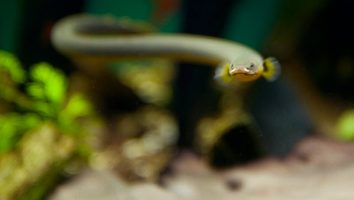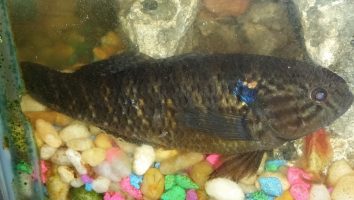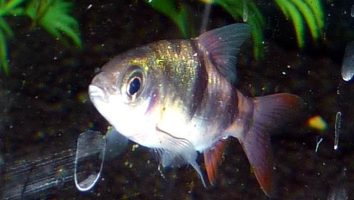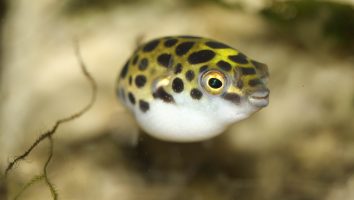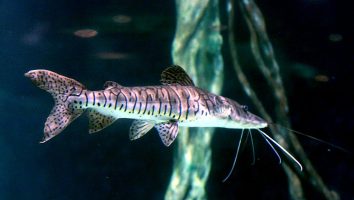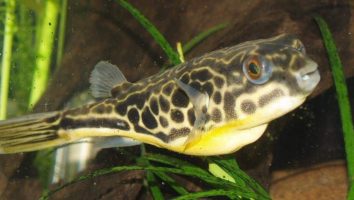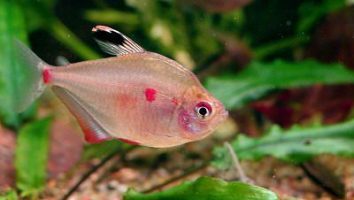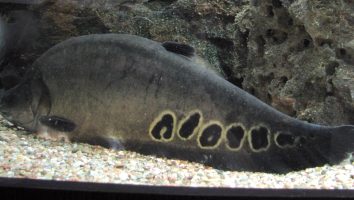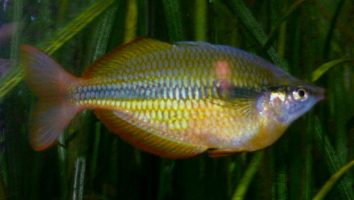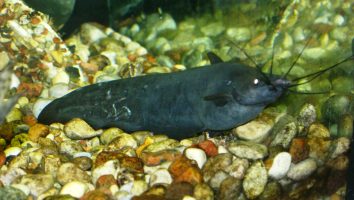The Three-Stripe Dwarf Cichlid is a beautiful freshwater fish that’s perfect for beginner aquarists.
This species is relatively easy to care for and is very peaceful, making them a great addition to any community tank.
They’re also relatively small, so they don’t need a huge tank. A 20-gallon tank is more than enough for a small group of these fish.
In this guide, we’ll teach you everything you need to know about Three-Stripe Dwarf Cichlid care. Tank size, diet, lifespan, tank mates, and more.
Table of contents
Species overview
Three-Stripe Dwarf Cichlids (Apistogramma trifasciatum) are a relatively small species of cichlid that’s found in South America, specifically in Peru, Colombia, and Brazil.
They prefer slow-moving water with plenty of vegetation and hiding places. This is something that’s common among many species of cichlid since they often come from rivers and streams in the wild.
Three-Stripe Dwarf Cichlids are a peaceful species that can be kept with other fish that have a similar temperament. They’re not known to be aggressive, although they may occasionally quarrel with each other.
These fish get their name from the three black stripes that run vertically down their body. This is a very distinct feature that makes them stand out from other types of cichlids.
Appearance
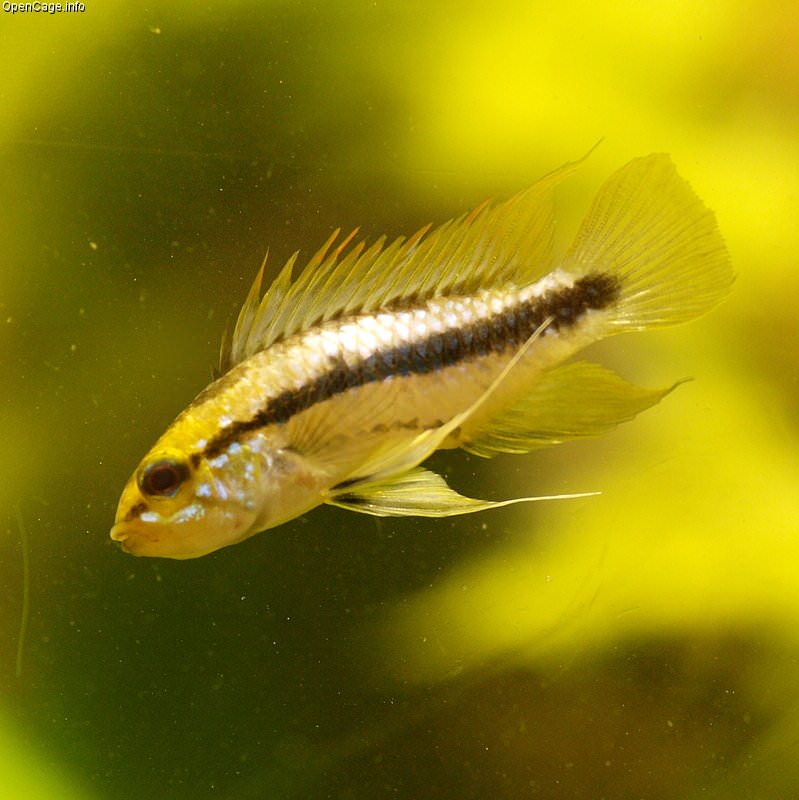
Three-Stripe Dwarf Cichlids are one of the more drab-looking fish on this list. They’re mostly a light brown color with three dark stripes running vertically down their bodies.
The center stripe is the darkest and thickest, while the two on the outside are a bit thinner.
These fish have a torpedo-like body shape that’s common among many freshwater species. They’re quite slim with a long dorsal fin that starts about halfway back on their bodies.
This dorsal fin is very tall and thin, almost matching the height of their anal fin. Both of these fins have a pointed end.
The caudal fin on Three-Stripe Dwarf Cichlids is forked and slightly taller than their dorsal and anal fins.
All of the fins on this fish are translucent with a slight tint of yellow.
The face of these fish is rather long with big eyes that sit on the sides of their head. The mouth of the Three-Stripe Dwarf Cichlid is downturned which is common among many bottom-feeding fish.
Lifespan
Three-Stripe Dwarf Cichlids have an average lifespan of 3 to 5 years. As with most fish, there are a number of things that can impact their lifespan.
If they’re kept in poor water conditions or are stressed from bad tank mates, their lifespan will be on the lower end of this range.
Conversely, if they’re kept in good water conditions with peaceful tank mates, they can easily live to be 5 years or older.
Size
The Three-Stripe Dwarf Cichlid is a small fish, only reaching a maximum size of about 2.5 inches. These cichlids are perfect for smaller aquariums or those who don’t want to deal with a lot of fish waste.
Tank
Tank Size
A minimum of 20 gallons is recommended for a single Three-Stripe Dwarf Cichlid, with an additional 10 gallons added for each additional fish.
While 20 gallons is technically the minimum, we recommend going up to a 30 or 40-gallon tank if you want to keep more than one of these cichlids. They are active swimmers and will appreciate the extra space.
Water Parameters
The three-stripe dwarf cichlid is a freshwater fish that is native to the rivers of South America. In the wild, they inhabit slow-moving waters with plenty of hiding spots and vegetation.
These cichlids are relatively small, only reaching about 2.5 inches in length when fully grown. Despite their small size, they are very active fish that need plenty of space to swim and explore.
They are also very social fish that do best in groups. A single fish is likely to become stressed and may even become aggressive.
When it comes to water parameters, the three-stripe dwarf cichlid is very adaptable. They can tolerate a wide range of water conditions, making them a good choice for beginner aquarium hobbyists.
Here are a few guidelines to help you create a healthy environment for your three-stripe dwarf cichlids.
- Water temperature: 73 to 81 degrees Fahrenheit
- pH levels: 6.5 to 7.8
- Water hardness: 4 to 18 dGH
- Alkalinity Levels: 2-12 dKH
What To Put In Their Tank
Three-Stripe Dwarf Cichlids are a peaceful species that make a great addition to any community tank. They’re not too demanding when it comes to their habitat, but there are still a few things you should keep in mind.
The substrate is an important part of their environment. We recommend using a soft, sandy substrate to make things as comfortable as possible for them.
These cichlids love to dig and root around in the substrate, so anything too hard could end up hurting them.
As for plants, you can include some if you want but be prepared for them to be uprooted. These cichlids love to dig and can easily uproot plants.
If you do want to add plants, we recommend choosing something sturdy that can withstand a little abuse. Hornwort, Java Moss, and Water Wisteria are all good choices.
In terms of decoration, these cichlids are not too picky. They’ll appreciate some hiding spots and places to explore, but anything else is up to you.
Just avoid anything too sharp or pointy. These cichlids like to dig and can easily hurt themselves on anything that’s too hard.
Common Diseases
There are a few diseases that you need to be aware of when keeping three-stripe dwarf cichlids. Thankfully, these fish are relatively hardy and don’t fall ill often.
The most common disease that you’ll see in these fish is ich. This is a parasite that affects freshwater fish of all kinds, and it can be quite serious if left untreated.
The most obvious symptom of ich is the presence of white spots on the body of your fish. If you see this, it’s important to act fast and begin treatment immediately.
Another disease that affects three-stripe dwarf cichlids (and other freshwater fish) is Hole-in-the-Head disease. This is caused by poor water quality and the presence of activated carbon in the tank.
It’s characterized by one or two pits/holes in the head of your fish. While it’s not usually fatal, it can be quite ugly and it will usually leave some scarring.
As always, the best way to prevent your fish from getting sick is to maintain a clean and stable tank. This will go a long way in keeping your fish healthy and happy.
Behavior & Temperament
Three-Stripe Dwarf Cichlids are one of the more peaceful cichlid species. They’re also pretty small, which makes them a good option for beginner aquarists.
While they are peaceful, that doesn’t mean they don’t have a bit of an aggressive streak. These fish are known to be nippy, so don’t put them in a tank with fish that are easily intimidated. They may also chase other fish around the tank, but they typically won’t hurt them.
Three-Stripe Dwarf Cichlids are also known to be a bit shy, so it’s important to provide them with plenty of hiding places. Plants, rocks, and caves are all good options. If you don’t provide them with a place to hide, they may become stressed, which can lead to health problems.
Tank Mates
The Three-Stripe Dwarf Cichlid is a peaceful fish that does well in community tanks. They’re not aggressive and won’t bother other fish.
In terms of water conditions, these fish come from soft, acidic water in the wild. As a result, they’re well-suited for similar setups in the home aquarium.
To help get you started, here are some compatible tank mates that tend to work well:
- Neon Tetra
- Cardinal Tetra
- Guppy
- Platy
- Mollies
- Swordtail
- Endler’s Livebearer
- Cherry Shrimp
- Ghost Shrimp
Breeding
The Three-Stripe Dwarf Cichlid is a fairly easy fish to breed as long as you provide them with the right habitat and water conditions.
This species is mouthbrooding, which means that the female will carry the eggs in her mouth until they hatch.
To trigger spawning, you’ll need to make sure the water is between 77 and 86 degrees Fahrenheit. The pH should be between 7.0 and 8.0.
You’ll also need to put a group of cichlids together (around six). It’s best to have two females for every male.
Once the female is ready to lay her eggs, she’ll do so on a flat surface. The male will then fertilize them.
After that, the female will pick up the eggs in her mouth and carry them around until they hatch (which takes about two weeks).
Once the fry have hatched, you can start feeding them baby brine shrimp and other small foods.
Conclusion
The Three-Stripe Dwarf Cichlid is a great fish for beginner aquarists. They’re beautiful, easy to care for, and get along well with other fish.
We highly recommend this fish to anyone who is looking for a low-maintenance pet that will still add some excitement to their tank.

